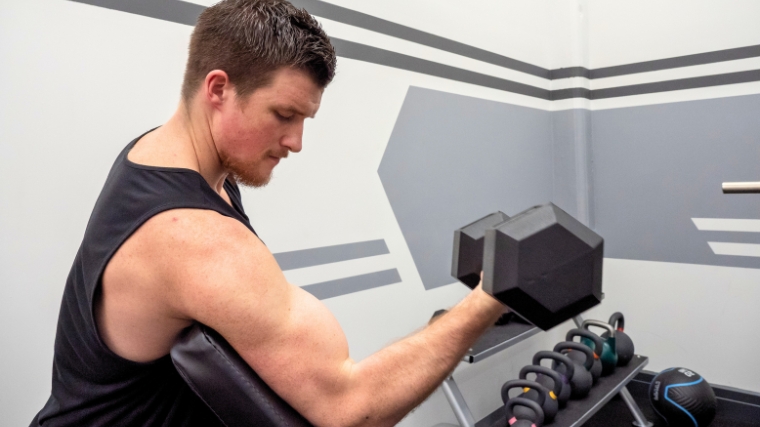Regarding fitness and body image, many individuals focus on specific areas, such as the biceps, in their quest for an aesthetically pleasing physique.
The average bicep size for adults is approximately 12-15 inches for men and 10-12 inches for women. However, individual measurements may vary based on genetics, age, and fitness level.
Understanding what constitutes an average bicep size, as well as the factors that influence it, can provide valuable insight into achieving your desired arm measurements. Let’s Explore.
Introduction To Bicep Size:
Bicep size refers to the measurement or circumference of the biceps muscle, typically taken at the fullest part of the upper arm.
It is an indicator of muscle mass and strength in the arms. Bicep size can vary depending on genetics, exercise routine, and overall fitness level.
Factors Affecting Bicep Size:
1. Genetics:
Genetic predisposition significantly determines an individual’s muscle size and shape, including the biceps. Some people may naturally have more significant or more defined biceps due to their genetic makeup.
2. Exercise Routine:
The type and intensity of your exercise routine can impact your bicep size. Compound exercises like bicep curls, chin-ups, and rows can help stimulate arm muscle growth.
3. Nutrition:

Proper nutrition is essential for muscle growth and development. Consuming adequate protein, carbohydrates, and healthy fats can give your muscles the necessary nutrients to grow and recover effectively.
4. Rest And Recovery:
Allowing your muscles time to rest and recover is crucial for optimal growth. Overtraining can lead to muscle fatigue and hinder progress, so incorporate rest days into your workout routine.
What Is Considered An Average Bicep Size?
The average bicep size can vary depending on age, gender, and fitness levels. However, a rough estimate for average bicep size in adults is around 12-15 inches for men and 10-12 inches for women.
How To Measure Bicep Size Accurately:
- Use A Flexible Measuring Tape:
Obtain a flexible measuring tape, preferably made of cloth or plastic, as it will conform better to the shape of your arm.
- Find The Fullest Part Of Your Bicep:
Locate the fullest part of your bicep muscle. This is typically the area where your bicep looks the largest and most pronounced.
- Relax Your Arm:
Allow your arm to hang naturally at your side in a relaxed position. Avoid flexing or tensing your muscles, as this can distort the measurement.
- Wrap The Tape Around Your Bicep:
Wrap the measuring tape around the fullest part of your bicep. Ensure that the tape is snug against your skin but not too tight, as this could affect the accuracy of the measurement.
- Take The Measurement:
Once the tape is securely placed, note the measurement in inches or centimeters. Take the measurement a few times to ensure accuracy, and record the average if there are slight variations.
- Record The Measurement:
Write down the measurement for future reference. You can track changes in your bicep size over time by taking measurements regularly under consistent conditions.
Tips For Increasing Bicep Size:
1. Incorporate Variety:
Incorporate various bicep exercises into your workout routine to target different muscle areas. Include exercises like bicep, hammer, and concentration curls to stimulate growth from multiple angles.
2. Focus On Progressive Overload:

Gradually increase the weight or resistance used in your bicep exercises over time. Progressive overload is essential for muscle growth, so challenge your muscles with heavier weights or more reps as you become stronger.
3. Maintain Proper Form:
Focus on maintaining proper form during bicep exercises to maximize muscle activation and minimize the risk of injury.
Avoid swinging or using momentum to lift the weight, and ensure controlled movements throughout each repetition.
4. Mind Your Grip:
Experiment with different grips, such as comprehensive, narrow, and neutral grips, to target other parts of the bicep muscle. Varying your grip can help stimulate new muscle fibers and promote overall growth.
5. Include Eccentric Movements:
Incorporate eccentric (adverse) movements into your bicep exercises by slowing down the lowering phase of each repetition.
Eccentric contractions cause muscle damage, stimulating growth when combined with proper recovery.
Common Mistakes To Avoid While Increasing Bicep Size:
1. Overtraining:
While training your biceps frequently for faster results is tempting, overtraining can lead to muscle fatigue and hinder growth.
Ensure you allow your muscles sufficient time to rest and recover between workouts to prevent burnout.
2. Neglecting Other Muscle Groups:
Focusing solely on bicep exercises without addressing other muscle groups can lead to muscular imbalances and increase the risk of injury.
Incorporate a balanced workout routine that targets all major muscle groups for optimal strength and symmetry.
3. Poor Form:
Maintaining proper form during bicep exercises is essential for targeting the muscles effectively and reducing the risk of injury.
Avoid using momentum to lift the weight, and ensure controlled movements throughout each repetition to maximize muscle activation.
4. Ignoring Eccentric Movements:

Neglecting the eccentric (negative) phase of bicep exercises can limit muscle growth potential. Slow down the lowering phase of each repetition to fully engage the muscle and stimulate growth through eccentric contractions.
5. Not Prioritizing Nutrition:
Proper nutrition is crucial for muscle growth and recovery. Ensure you’re consuming enough calories and nutrients to support your training goals, focusing on protein-rich foods to fuel muscle repair and growth.
6. Lack Of Hydration:
Dehydration can impair muscle function and hinder performance during workouts. Drink plenty of water throughout the day to support muscle hydration and nutrient delivery.
7. Skipping Rest And Recovery:
Adequate rest and recovery are essential for muscle growth. Avoid the temptation to train the biceps excessively and prioritize rest days to allow your muscles time to repair and grow stronger.
8. Ignoring Warning Signs:
Pay attention to your body and avoid pushing through pain or discomfort during workouts. Listen to warning signs such as joint pain or muscle fatigue, and adjust your workout intensity or technique accordingly to prevent injury.
Conclusion
In conclusion, understanding what constitutes an average bicep size and the factors that influence it can help you achieve your desired arm measurements. You can increase your bicep size and overall muscle mass by incorporating a balanced exercise routine, proper nutrition, and adequate rest.
Related Questions:
1. How Long Does It Take To Increase Bicep Size?
The timeline for increasing bicep size varies depending on genetics, exercise routine, and nutrition. With consistent effort, noticeable results can typically be seen within a few months.
2. Can Women Build Bigger Biceps?
Yes, women can build bigger biceps through resistance training and proper nutrition. While they may not reach the same size as men due to differences in hormonal profiles, women can still significantly increase their bicep size.
3. Should I Train My Biceps Every Day To Make Them Bigger?
Training your biceps daily can lead to overuse injuries and hinder muscle growth. Allowing your muscles sufficient time to rest and recover between workouts is essential.
4. Does Genetics Play A Role In Bicep Size?
Genetics plays a significant role in determining an individual’s muscle size and shape, including the biceps. Some people may naturally have more critical or defined biceps due to their genetic makeup.
5. Can I Increase My Bicep Size Without Weights?
While resistance training is one of the most effective ways to increase bicep size, bodyweight exercises such as chin-ups, push-ups, and dips can also help stimulate muscle growth.
Read:
